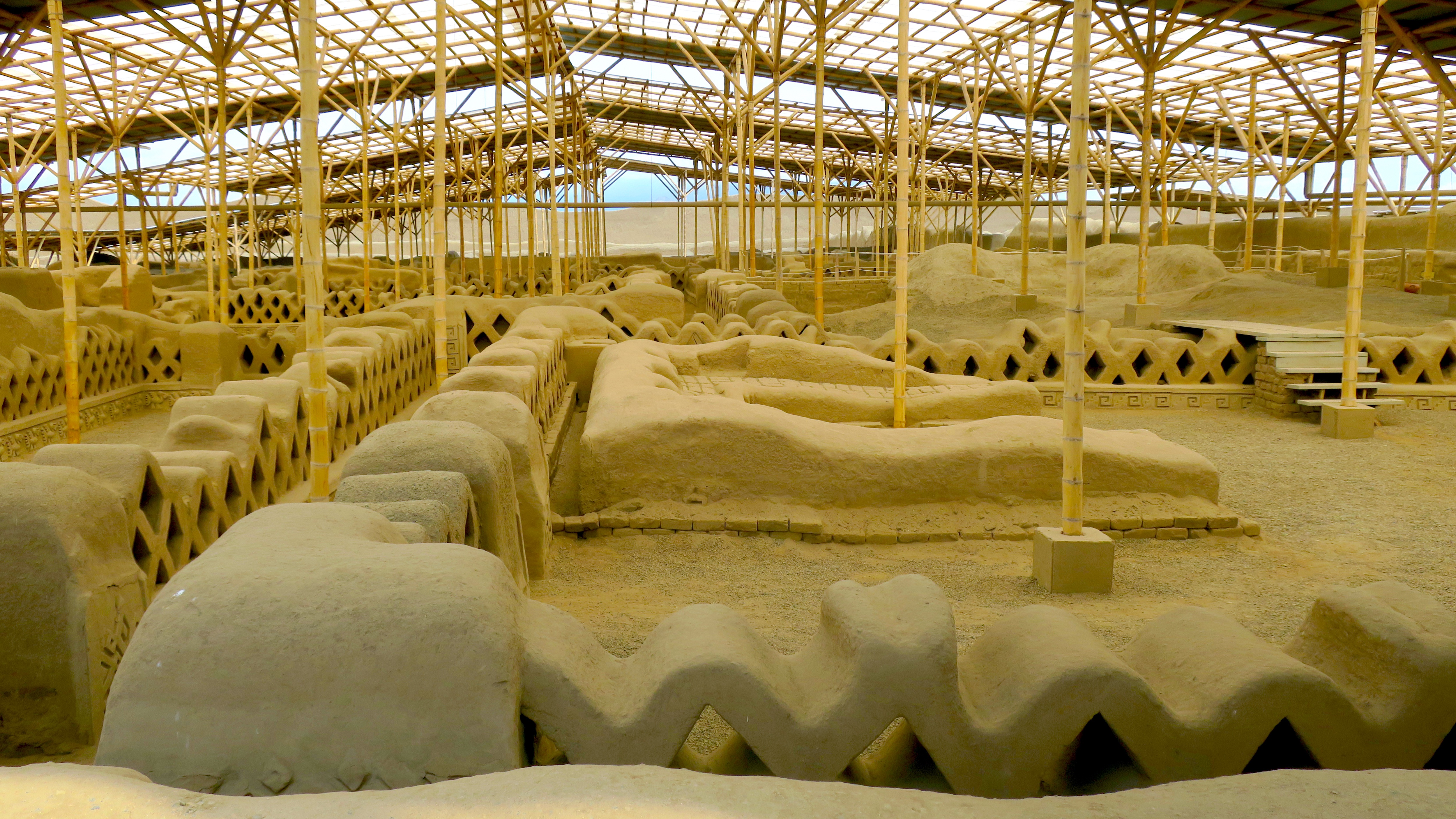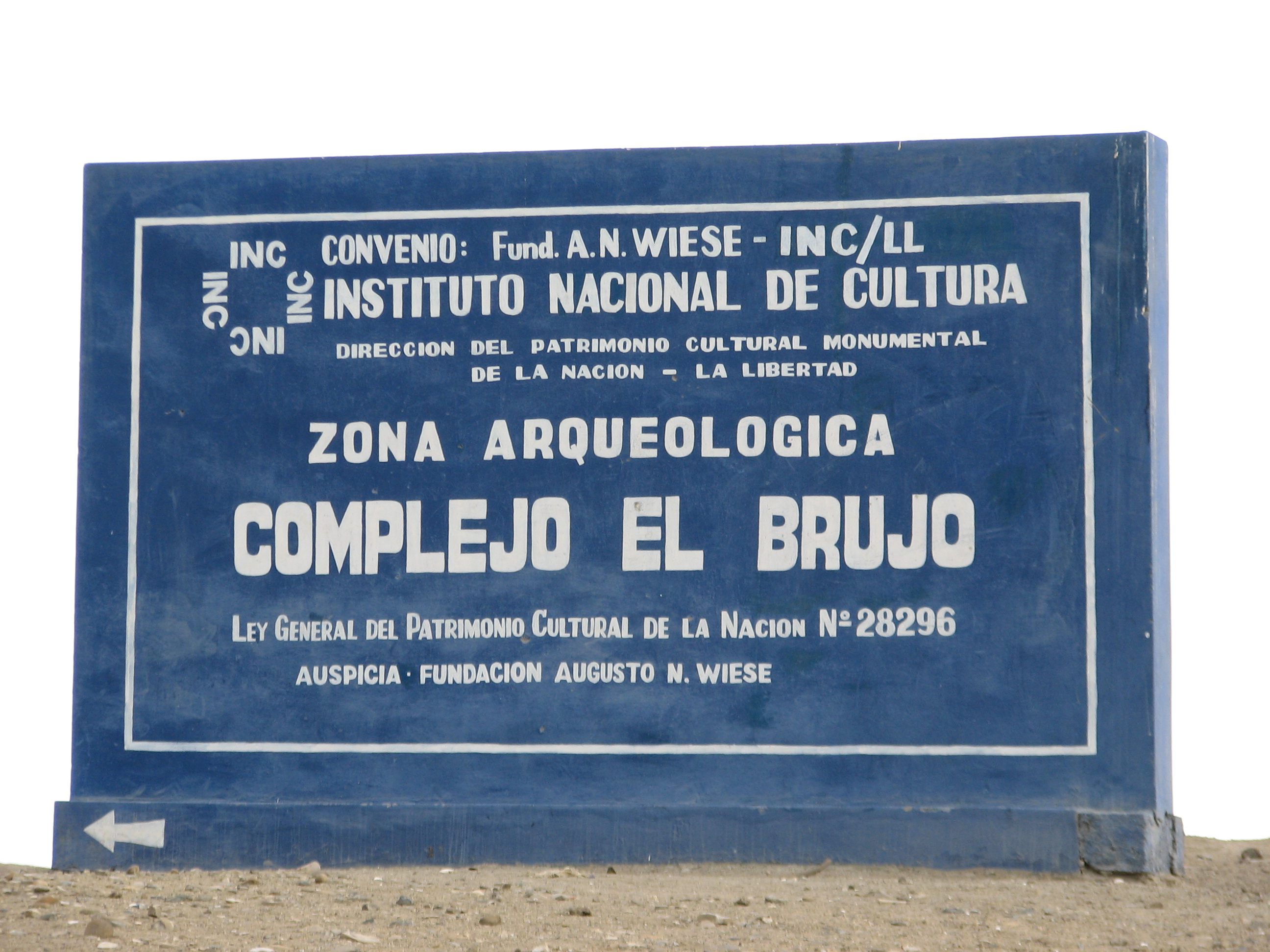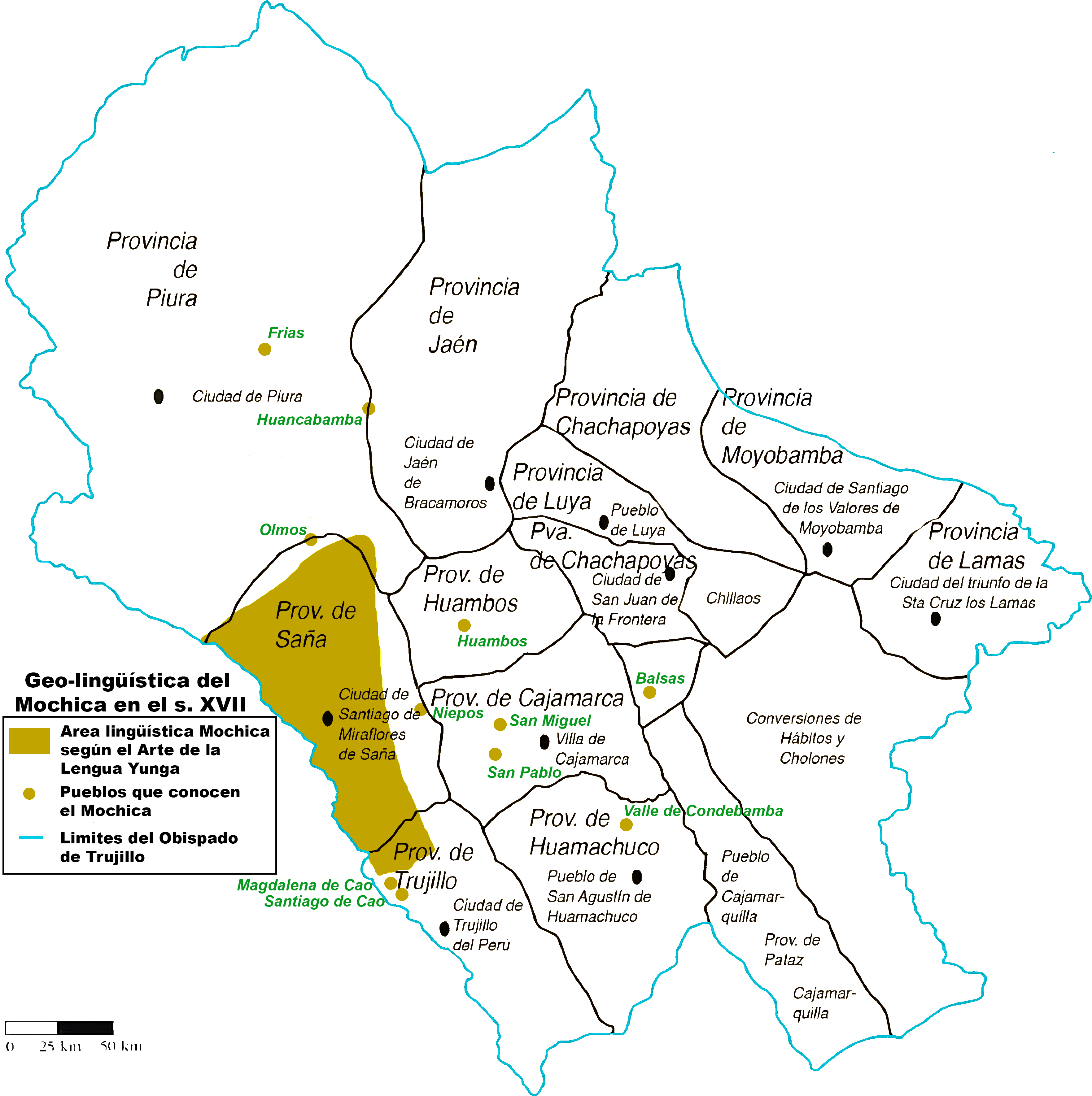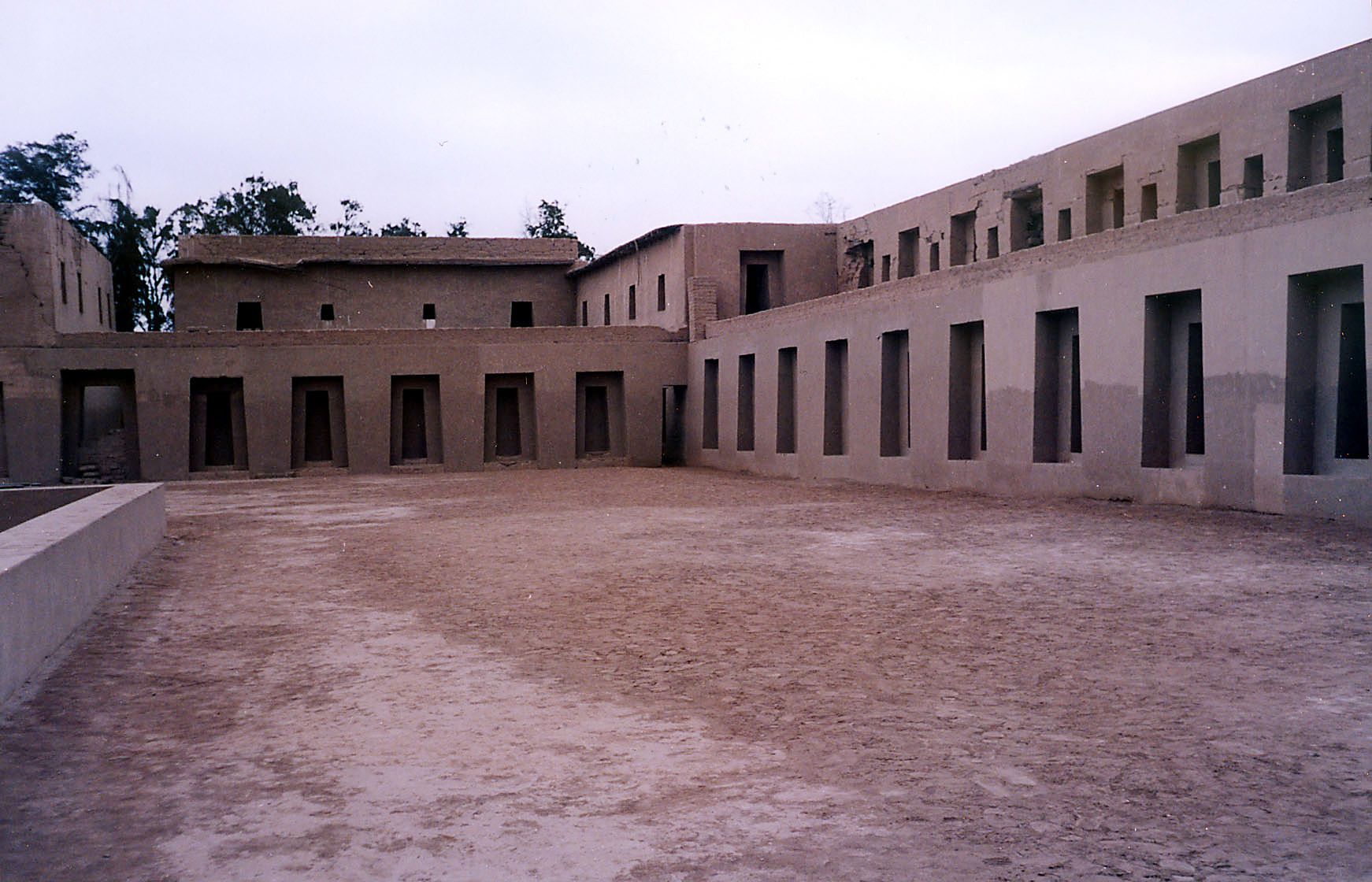|
Quingnam
file:Lenguas del obispado de Trujillo.jpg, 300px, in the Bishopric of Trujillo, the ''Trujillo, Peru, city of Trujillo'' is shown as the main representative place of this language The Quingnam language was a pre-Columbian language that was spoken by the Chimú people, who lived in the former territories of the Moche culture, Mochicas: an area north of the Chicama Chao River Valley. At the height of Chimú conquests, the language was spoken extensively from the Jequetepeque River in the north, to the Carabayllo River, Carabayllo (near present-day Lima) in the south. Fishermen along the Chimú coast spoke a language called ''Lengua Pescadora'' (fisherman language) by Spanish missionaries, and disambiguated as Yunga Pescadora by linguists; this may be the same as Quingnam. A letter found during excavations at Magdalena de Cao Viejo in the El Brujo, El Brujo Archaeological Complex includes a list of decimal numerals which may be Quingnam or Pescadora, but they are not Mochica languag ... [...More Info...] [...Related Items...] OR: [Wikipedia] [Google] [Baidu] |
Chan Chan
Chan Chan (), sometimes itself called Chimor, was the capital city of the Chimor kingdom. It was the largest city of the pre-Columbian era in South America. It is now an archeological site in the department of La Libertad west of Trujillo, Peru. Chan Chan is located in the mouth of the Moche Valley and was the capital of the historical empire of the Chimor from 900 to 1470, when they were defeated and incorporated into the Inca Empire. Chimor, a conquest state, developed from the Chimú culture which established itself along the Peruvian coast around 900 CE. Chan Chan is in a particularly arid section of the coastal desert of northern Peru. Due to the lack of rain in this area, the major source of nonsalted water for Chan Chan is in the form of rivers carrying surface runoff from the Andes. This runoff allows for control of land and water through irrigation systems. The city of Chan Chan spanned and had a dense urban center of which contained extravagant ''ciudade ... [...More Info...] [...Related Items...] OR: [Wikipedia] [Google] [Baidu] |
Peru
Peru, officially the Republic of Peru, is a country in western South America. It is bordered in the north by Ecuador and Colombia, in the east by Brazil, in the southeast by Bolivia, in the south by Chile, and in the south and west by the Pacific Ocean. Peru is a Megadiverse countries, megadiverse country, with habitats ranging from the arid plains of the Pacific coastal region in the west, to the peaks of the Andes mountains extending from the north to the southeast of the country, to the tropical Amazon basin rainforest in the east with the Amazon River. Peru has Demographics of Peru, a population of over 32 million, and its capital and largest city is Lima. At , Peru is the List of countries and dependencies by area, 19th largest country in the world, and the List of South American countries by area, third largest in South America. Pre-Columbian Peru, Peruvian territory was home to Andean civilizations, several cultures during the ancient and medieval periods, and has one o ... [...More Info...] [...Related Items...] OR: [Wikipedia] [Google] [Baidu] |
El Brujo
Located in the Chicama Valley, the El Brujo Archaeological Complex, just north of Trujillo, Peru, Trujillo, La Libertad Region, La Libertad Province, Peru, is an ancient archaeological site that was occupied from preceramic times. Considering the broad cultural sequencing, the Chicama Valley can be considered as an archaeological microcosm. Research at the site benefits from the favourable environmental and topological conditions for material conservation. Huaca Prieta is the earliest part of the complex but the biggest constructions on the site belong to the Moche culture. In this area, there are also the remains of the later Lambayeque culture, Lambayeque and Chimú culture, Chimú cultures. Early Intermediate Period The development of the Brujo Archaeological Complex during the Intermediate Period falls within a context of early complex societies construction. During the Moche era, monumental religious and socio-political centers usually named huacas were built. Although th ... [...More Info...] [...Related Items...] OR: [Wikipedia] [Google] [Baidu] |
Chimú Culture
Chimor (also Kingdom of Chimor or Chimú Empire) was the political grouping of the Chimú culture (). The culture arose about 900 CE, succeeding the Moche culture, and was later conquered by the Inca emperor Topa Inca Yupanqui around 1470, fifty years before the arrival of the Spanish in the region. Chimor was the largest kingdom in the Late Intermediate Period, encompassing 1,000 kilometres (620mi) of coastline. According to Chimú oral history, the history of Chimor began with the arrival of Taycanamo in the Moche Valley from the sea on a balsa raft. From there, his descendants would conquer surrounding areas starting with his son Guacriur. Guacricur integrated Chimú's reign over the lower valley and Ñancempinco, Taycanamo's grandson would expand the kingdom by conquering the upper valley. Ñançenpinco began to further expansion both north and south of the Moche Valleys. The first valleys seem to have joined forces willingly, but the Sican culture was acquired th ... [...More Info...] [...Related Items...] OR: [Wikipedia] [Google] [Baidu] |
Quechua II
Quechua (, ), also called (, 'people's language') in Southern Quechua, is an indigenous language family that originated in central Peru and thereafter spread to other countries of the Andes. Derived from a common ancestral " Proto-Quechua" language, it is today the most widely spoken pre-Columbian language family of the Americas, with the number of speakers estimated at 8–10 million speakers in 2004,Adelaar 2004, pp. 167–168, 255. and just under 7 million from the most recent census data available up to 2011. Approximately 13.9% (3.7 million) of Peruvians speak a Quechua language. Although Quechua began expanding many centuries before the Incas, that previous expansion also meant that it was the primary language family within the Inca Empire. The Spanish also tolerated its use until the Peruvian struggle for independence in the 1780s. As a result, various Quechua languages are still widely spoken today, being co-official in many regions and the most spoken language in ... [...More Info...] [...Related Items...] OR: [Wikipedia] [Google] [Baidu] |
Magdalena De Cao
Magdalena de Cao is a town in Northern Peru, capital of the district Magdalena de Cao of Ascope Province in the region La Libertad. This town is located some 56 km northwest of Trujillo city in the agricultural Chicama Valley. See also * Paiján culture * Ascope Province *Chavimochic *Virú Valley *Virú Virú is a town in Northern Peru, capital of the province Virú in the region La Libertad. This town is located 48 km south Trujillo city and is primarily an agricultural center in the Viru Valley. In the 1960s around 850 families lived in t ... * Moche valley External linksLocation of Magdalena de Cao by Wikimapia References {{Peru-geo-stub Populated places in the Department of La Libertad ... [...More Info...] [...Related Items...] OR: [Wikipedia] [Google] [Baidu] |
Conquistador
Conquistadors (, ) or conquistadores (; ; ) were Spanish Empire, Spanish and Portuguese Empire, Portuguese colonizers who explored, traded with and colonized parts of the Americas, Africa, Oceania and Asia during the Age of Discovery. Sailing beyond the Iberian Peninsula, they established numerous Colony, colonies and trade routes, and brought much of the "New World" under the dominion of Spain and Portugal. After Christopher Columbus's arrival in the West Indies in 1492, the Spanish, usually led by Hidalgo (nobility), hidalgos from the west and south of Spain, began building a colonial empire in the Caribbean using colonies such as Captaincy General of Santo Domingo, Santo Domingo, Captaincy General of Cuba, Cuba, and Captaincy General of Puerto Rico, Puerto Rico as their main bases. From 1519 to 1521, Hernán Cortés led the Spanish conquest of the Aztec Empire, ruled by Moctezuma II. From the territories of the Aztec Empire, conquistadors expanded Spanish rule to northern Ce ... [...More Info...] [...Related Items...] OR: [Wikipedia] [Google] [Baidu] |
Mochica Language
Mochica is an extinct language formerly spoken along the northwest coast of Peru and in an inland village. First documented in 1607, the language was widely spoken in the area during the 17th century and the early 18th century. By the late 19th century, the language was dying out and spoken only by a few people in the village of Etén, in Chiclayo. It died out as a spoken language around 1920, but certain words and phrases continued to be used until the 1960s. A revival movement has appeared in recent times. Classification Mochica is usually considered to be a language isolate, but has also been hypothesized as belonging to a wider Chimuan language family. Stark (1972) proposes a connection with Uru–Chipaya as part of a Maya–Yunga–Chipayan macrofamily hypothesis. Denominations The ''yunga'' form is mentioned in the work of Fernando de la Carrera, "''yunca''" is another form mentioned by varieties of Quechua, "''muchic''" is only mentioned by the Augustinian father ... [...More Info...] [...Related Items...] OR: [Wikipedia] [Google] [Baidu] |
Yunga Pescadora
Yunga may refer to: * Yunga region of Peru, Bolivia, and northern Argentina * Yunga District, a district of Peru * two provinces of Bolivia: Nor Yungas Province and Sud Yungas Province * Yunga language (Peru) * Yunga language (Australia) * Yunga people (Australia), an ethnic group See also * Yungas Cocalera Revolution, a political group in Bolivia * Yungas Road The Yungas Road, popularly known as the Death Road, is a long cycle route linking the city of La Paz, Bolivia, La Paz with the Yungas region of Bolivia. It was conceived in the 1930s by the Politics of Bolivia, Bolivian government to connect ..., a cycle route in Bolivia {{Disambiguation, geo Language and nationality disambiguation pages ... [...More Info...] [...Related Items...] OR: [Wikipedia] [Google] [Baidu] |
Lima
Lima ( ; ), founded in 1535 as the Ciudad de los Reyes (, Spanish for "City of Biblical Magi, Kings"), is the capital and largest city of Peru. It is located in the valleys of the Chillón River, Chillón, Rímac River, Rímac and Lurín Rivers, in the desert zone of the central coastal part of the country, overlooking the Pacific Ocean. The city is considered the political, cultural, financial and commercial center of Peru. Due to its geostrategic importance, the Globalization and World Cities Research Network has categorized it as a "beta" tier city. Jurisdictionally, the metropolis extends mainly within the province of Lima and in a smaller portion, to the west, within the Constitutional Province of Callao, where the seaport and the Jorge Chávez Airport are located. Both provinces have regional autonomy since 2002. The 2023 census projection indicates that the city of Lima has an estimated population of 10,092,000 inhabitants, making it the List of cities in the Americas b ... [...More Info...] [...Related Items...] OR: [Wikipedia] [Google] [Baidu] |
Carabayllo River
Carabayllo may refer to: * Carabayllo District Carabayllo () is one of the 43 districts of the province Lima in Peru. It is located in the Cono Norte area of the province and was created district by General José de San Martín in August 4, 1821 at which time it was the only district to occ ..., Peru * Roman Catholic Diocese of Carabayllo, Peru {{geodis ... [...More Info...] [...Related Items...] OR: [Wikipedia] [Google] [Baidu] |




